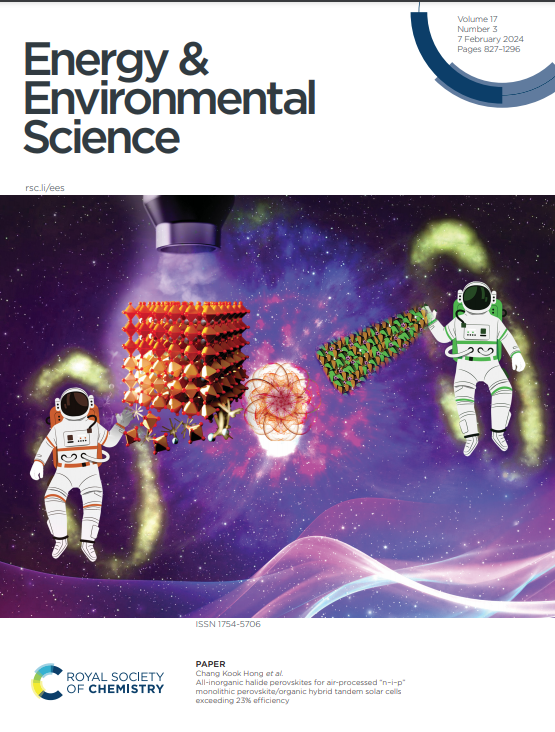The Spontaneous Cascade Optimization Strategy of the Double Enrichment Improves Anion-Derived Solid Electrolyte Interphases to Enable Stable Lithium-Metal Batteries
IF 32.4
1区 材料科学
Q1 CHEMISTRY, MULTIDISCIPLINARY
引用次数: 0
Abstract
Anion regulation to generate LiF-rich solid electrolyte interfaces (SEIs) represents a highly effective, convenient, and economical approach. The anion decomposition process is influenced by charge density and anion concentration. However, current research primarily concentrates on increasing charge density to enhance anion decomposition. Herein, the spontaneous cascade optimization strategy driven by the double enrichment of anions and charges is proposed by utilizing NH2-MIL-101(Fe)@Copc (MOF@Copc). Specifically, NH2-MIL-101(Fe) functions as the TFSI- anion trap via the Lewis acid-base interactions and synergistic hydrogen bonding, thereby achieving primary optimization. Subsequently, the rich electronic structure of Copc facilitates charge delocalization and lowers the energy barrier for anion decomposition, allowing the C-F bonding to break more readily, thereby enabling further optimization. The π-π stacking interaction between the MOF and Copc facilitates the close association of adsorption and catalytic sites, allowing the continuous breakdown of the C- F series products in a chain reaction. The assembled LFP (19.26 mg cm⁻²) demonstrates a commercial-grade cathode area capacity, maintaining over 90% capacity retention across 350 cycles at 1 C, with a capacity decay rate of only 0.02% per cycle. More importantly, this strategy enables the industrial-scale production of Ah-class anode-free lithium-metal pouch batteries exceeding 300 Wh kg-1. Optimizing anion decomposition provides a novel perspective to advance the practical application of lithium-metal batteries.双重富集的自发级联优化策略改善了阴离子衍生固态电解质相间层,从而实现了稳定的锂金属电池
阴离子调节生成富锂固体电解质界面(SEIs)是一种高效、方便和经济的方法。负离子分解过程受电荷密度和负离子浓度的影响。然而,目前的研究主要集中在增加电荷密度来促进阴离子的分解。本文利用NH2-MIL-101(Fe)@Copc (MOF@Copc),提出了阴离子和电荷双富集驱动的自发级联优化策略。具体来说,NH2-MIL-101(Fe)通过Lewis酸碱相互作用和协同氢键发挥TFSI-阴离子阱的作用,从而实现了初级优化。随后,Copc丰富的电子结构有利于电荷离域,降低阴离子分解的能垒,使C-F键更容易断裂,从而使进一步优化成为可能。MOF和Copc之间的π-π堆叠相互作用促进了吸附位点和催化位点的紧密结合,使C- F系列产物在链式反应中连续分解。组装的LFP (19.26 mg cm - 2)展示了一个商业级的阴极面积容量,在1c下循环350次,容量保持在90%以上,每次循环的容量衰减率仅为0.02%。更重要的是,该策略可以实现超过300 Wh kg-1的ah级无阳极锂金属袋电池的工业规模生产。优化阴离子分解为推进锂金属电池的实际应用提供了新的视角。
本文章由计算机程序翻译,如有差异,请以英文原文为准。
求助全文
约1分钟内获得全文
求助全文
来源期刊

Energy & Environmental Science
化学-工程:化工
CiteScore
50.50
自引率
2.20%
发文量
349
审稿时长
2.2 months
期刊介绍:
Energy & Environmental Science, a peer-reviewed scientific journal, publishes original research and review articles covering interdisciplinary topics in the (bio)chemical and (bio)physical sciences, as well as chemical engineering disciplines. Published monthly by the Royal Society of Chemistry (RSC), a not-for-profit publisher, Energy & Environmental Science is recognized as a leading journal. It boasts an impressive impact factor of 8.500 as of 2009, ranking 8th among 140 journals in the category "Chemistry, Multidisciplinary," second among 71 journals in "Energy & Fuels," second among 128 journals in "Engineering, Chemical," and first among 181 scientific journals in "Environmental Sciences."
Energy & Environmental Science publishes various types of articles, including Research Papers (original scientific work), Review Articles, Perspectives, and Minireviews (feature review-type articles of broad interest), Communications (original scientific work of an urgent nature), Opinions (personal, often speculative viewpoints or hypotheses on current topics), and Analysis Articles (in-depth examination of energy-related issues).
 求助内容:
求助内容: 应助结果提醒方式:
应助结果提醒方式:


